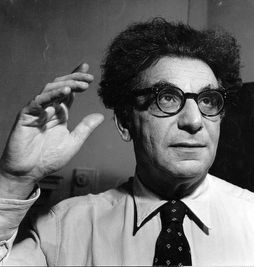- Alfred Wolfsohn
Infobox Person
name = Alfred Wolfsohn

image_size = 254px
caption = Alfred Wolfsohn
birth_date = September 23, 1896
birth_place = flagicon|GermanyGermany
death_date = February 5, 1962 (age 65)
death_place = flagicon|United KingdomUnited Kingdom
occupation =Singing teacher
spouse =
religion =
nationality =Alfred Wolfsohn (born September 23rd, 1896, died February 5th, 1962) was a German singing teacher. He taught
Charlotte Salomon , and figures in her paintings as Amadeus Daberlohn. He was the founder of a special style of voice training today known as the Roy Hart Theatre approach. His experiences of the cries of dying soldiers during World War I, and later his disgust at the artificially broadcast voices heard everywhere in Hitler's Berlin, led him to explore the nature and possibilities of the voice. A pioneer in the realms of voice research, his avant-garde studies revealed the potential of the voice as not only an instrument of artistic expression but also of human development and therapy. Wolfsohn's goal was to develop an unchained voice which he called The Voice of the Future.Early life
*23 Sept. 1896: Born in Berlin into a German-Jewish middle class family. His parents were religious but not strictly orthodox. When Wolfsohn was 10 years old, his father died of tuberculosis. He adored his mother singing to him a song with a high voice for an angel and a low voice for St Peter. He received a good education, felt himself to be a loner but loved football.
*1914: He was studying law at University when he was conscripted into the Army and fought on the Eastern front in World War I, later on the Western front. He suffered terrible traumas from the cries of pain and for not going to help one agonising soldier. He returned shell shocked and broken in health.
*1919/20: He travelled to Italy, re-found strength and inspiration. Returning to Germany, he abandoned law and decided he wanted to sing. His lack of progress with his teachers prompted him to develop his own theories integrating his appreciation of music, art, literature and current psychological studies of the time (notably
C.G. Jung ).*1933: Hitler’s party the National Socialists take over power. Jews were further discriminated against. Wolfsohn began his first manuscript “Orpheus or the Way to a Mask”.
inging teacher
*1935: When trying to get working papers for permission to teach singing, he was advised by Kurt Singer (Director of Berlin City Opera) to contact Paula Lindberg, the famous singer and
Charlotte Salomon ’s step-mother, for help. Wolfsohn gave Paula lessons and spoke of his own theories on the voice. First meetsCharlotte Salomon and talks with her for hours about art and creativity during the next years. Had no idea he had any influence on her.*1939: In January, Charlotte leaves for the south of France. A month later, Wolfsohn flees Berlin to London, helped by Alice Croner.
*1940: To avoid internment, Wolfsohn volunteers to join the Pioneer Corps, he is later invalided out.
*1943: Wolfsohn is given permission by the British Government to give singing lessons.
*1945: Wolfsohn begins his longest and most comprehensive manuscript “The Bridge”.
*1947:
Roy Hart meets Alfred Wolfsohn and starts taking lessons.*1949: Wolfsohn goes to Amsterdam for an operation with Dr Salomon, hears of Charlotte’s death but Dr Salomon knew nothing about the paintings at that time.
*1950’s: Wolfsohn has many students. Articles are written and contacts made with leading composers, musicians, actors, writers to pass on the work but there is no great response.
*1956: His star pupil, Jenny Johnson, performs in the Hoffnung Music Festival to good reviews. A record “Vox Humana” is issued by Folkways and is released in the US. Wolfsohn’s ill health intensifies. A BBC documentary with Wolfsohn is broadcast.
*1958: Aldous and Julian Huxley visit the studio.
*1959: Wolfsohn’s work is acknowledged by Dr Paul Moses, Speech and Voice Professor at Stanford University, San Francisco.
*5th Feb.1962: Wolfsohn's health deteriorates and he dies after developing a chest infection while in hospital. He had been teaching up to 10 days before his death.
Roy Hart , one of his most assiduous pupils, carries on with Wolfsohn's work.References
* [http://www.roy-hart.com Roy Hart Theatre Archives]
* The Prophet of Song, The life and work of Alfred Wolfsohn, Paul Newham,Tigers Eye Press, 1997ources
This page was created from material found at [http://www.roy-hart.com Roy Hart Theatre Archives] , with authorization.
Wikimedia Foundation. 2010.
